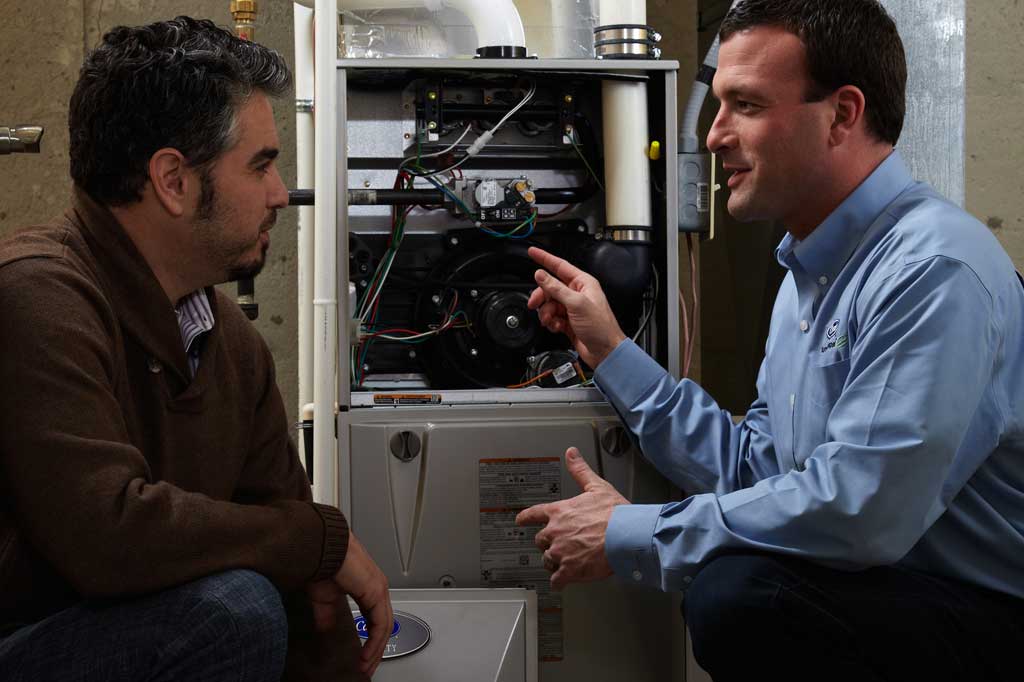Heat pumps use electricity to move heat from a cool space to a warm space, making the cool space cooler and the warm space warmer. During the heating season, heat pumps move heat from the cool outdoors into your warm house and during the cooling season, heat pumps move heat from your cool house into the warm outdoors. Because they move heat rather than generate heat, heat pumps can provide equivalent space conditioning at as little as one quarter of the cost of operating conventional heating or cooling appliances.

Trusted for sales and installation of new furnaces in the GTA & Ontario
When you want the most reliable heating services to help battle the cold of the Canadian winters, you can depend on Aire One Heating & Cooling for a residential furnace to keep your living space warm and reduce your heating costs.

Choosing the right A/C for you
When you choose our team for a new air conditioner we always take a need-based approach to ensure that you get the right air conditioning system for your home.
24-Hour
Emergency Repair
When you need help with your HVAC equipment in a hurry, you can count on our team to get to you fast. When you have an emergency, call us 24/7 and our HVAC technicians will be ready to help you.
Call us now 310-4328

Testimonials Reviews
FAQ
-
What is a heat pump?
-
What are mini-split advantages?
Just as the name implies, a “mini-split” system is a “split system” however available in smaller capacities, for single room to whole house conditioning. Mini-split systems may range from as small as 9,000 BTUh per hour, comparable to say, a small window AC unit, for individual room use, up to 4 and 5 ton capacities for “Room By Room” (also known as “Zoning”) and whole house conditioning. With near universal design, mini-splits are “heat pumps” which provide both heating and cooling for a home. Here are key advantages when compared to traditional split systems:
Efficiency- Mini-splits are highly engineered systems which offer attractive operating efficiencies, in many instances, eligible for utility company rebates.
Heat Pump- Most mini-split systems are heat pumps, providing year-round comfort.
Solar friendly- Due to very low power requirements, mini-splits are an ideal complement to “Net Zero Energy” homes, or any home using renewable power.
Carbon footprint- Mini-splits are 100% electric, with zero operating emissions of any type.
Zoning- Most mini-split manufacturers offer systems capable of room-by-room “zoning”, to account for peak demands of a room based upon construction type, exposure orientation and usage.
Variable capacity- Mini-splits are typically DC inverter driven. That is, a variable speed compressor which modulates in proportion to instantaneous demand. Most conventional split systems, by comparison, operate with an ON-OFF strategy. (Would you use an ON-OFF switch as the accelerator in your vehicle?)
Location, Location, Location!- Mini-split outdoor units are compact; they can be located far away from noise-sensitive areas, such as bedrooms and home offices. Mini-split indoor units have the ability to be installed where conventional systems cannot.
They’re perfect for additions and remodels where access to current HVAC system is difficult to access.
Modern mini-split systems are remarkably quiet; in fact, many times their operation is unnoticed by the end user. -
How do I know what size unit I need?
If you have any problems with your system, you should contact the contractor who installed the units. All our systems are covered by a 5 year parts, 7 year compressor limited warranty.
-
What is a mini-split?
By definition, and simply put, a “Split System” is a heating and air conditioning system which has two main components, the indoor unit and outdoor unit. In short, the indoor unit absorbs heat energy in the cooling mode, and the outdoor unit rejects the very heat absorbed by the indoor unit. And the cycle is repeated until the set temperature is met. Although the indoor and outdoor units are located in physically different, hence “split” locations, they are connected and operate as, one system; continuously circulating refrigerant liquid and vapor by means of interconnecting, dehydrated copper refrigerant lines, commonly referred to as a “Line Set”.
Popular blogs
The Dangers of Poor Indoor Air Quality (And How HVAC Can Fix It)
Indoor air quality (IAQ) plays a vital role in your health and comfort. Poor IAQ can lead to allergies, respiratory issues, and even long-term health conditions. Without proper ventilation and...
When to Repair vs. Replace Your HVAC System
Deciding whether to repair or replace your HVAC system can be a challenging decision. Several factors come into play, such as the system's age, efficiency, and the cost of repairs. Knowing when...
50% off on Furnace Protection/Insurance Plan!
Aire One Heating & Cooling is now offering a limited time promotion, to help you save on your furnace protection/insurance plan!
Get this deal!




